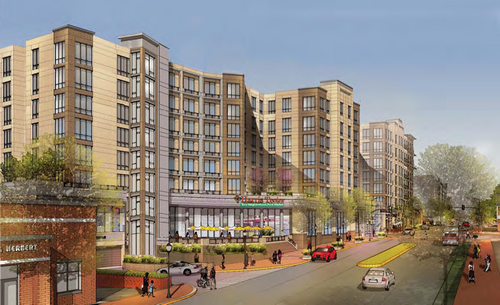With new mixed-use development, the “Little City” of Falls Church keeps growing up
The only way the City of Falls Church can grow is up. To expand its tax base, city leaders have been promoting mixed-use development and even blocking projects that aren’t mixed-use. This trend is taking another step with a new building under construction at 301 West Broad Street.
Broad Street is Falls Church’s major link to Tysons Corner, Seven Corners, and Alexandria. Within the city limits, the street features a mix of styles that reflect several eras in architectural history. There are low-slung commercial buildings, but 301 West Broad will add to a growing number of taller mixed-use buildings that are ramping up the density in Falls Church.
The building, by developer Rushmark, will be seven stories tall with 282 apartments. A Harris Teeter and another retail space will occupy the ground floor. The building is replacing a post office and a restaurant, Anthony’s, which had been at the site since 1972. Both have relocated, the post office to another mixed-use building up the street.
The “Little City” embraces urbanism
Nicknamed “the Little City,” Falls Church is only a bit larger than two square miles and is one of the smallest municipalities by area in the country. The city is so small that the city’s middle and high schools were actually located in Fairfax County until last year.
To fund city services on par with its much larger neighbors, Falls Church is actively embracing mixed use construction. City leaders recognize that mixed-use buildings offer more economic value on smaller parcels than typical suburban construction. Mixed-use also provides more tax revenue than single-use construction, even when the total building size is smaller.
Falls Church is actively planning for growth where the best opportunities exist. Besides directly on Broad Street, there are relatively large commercial parcels along South Washington Street and land it gained in a land swap with Fairfax County in 2012.
The city enjoys advantages for building smart growth compared to its larger neighbors. Most streets follow a grid pattern, and the city’s zip code, 22046, rates a Walk Score of 78 (“Very Walkable”). The W&OD Trail also runs through much of the city, and the Custis trailhead is close by.
While WMATA’s two Falls Church metro stations aren’t actually inside the city, residents aren’t more than a few minute bus ride to either one and service is frequent.
The Route 7 Corridor Study is examining transit options for route 7 between Tysons Corner and Alexandria. This could bring a potential light rail or a streetcar line right in front of 301 West Broad and put higher quality-transit close to residents all over the city.
Obstacles and opposition remain
The city’s small size and population makes it relatively easy for citizens to get involved in planning decisions, and there was a lot of input during the project’s design. The city’s Winter Hill neighborhood is adjacent to the project and many citizens weighed in, often with tentative support.
Some worried about the noise and trash in the back of the building from the grocery store’s loading dock. Some said that at 65,000 square feet, the Harris Teeter was larger than appropriate for what was supposed to be a more “urban” grocery store.
Rushmark responded by totally enclosing the loading dock and noting that a similar store in a mixed use development in Tysons Corner was around the same size.
Other residents were generally concerned about schools, roads, and parking. They said these impacts would outweigh the tax revenue from the new development. Meanwhile, members of the city’s planning commission reportedly worried that the building was too “urban” for the “suburban” city of Falls Church.
But Falls Church is in a unique position. It neighbors some of Northern Virginia’s biggest commercial areas. Its small town image has competed with the region’s growth for a long time. Still more changes to the “Little City” are coming, and the city may not stay so little for long.


